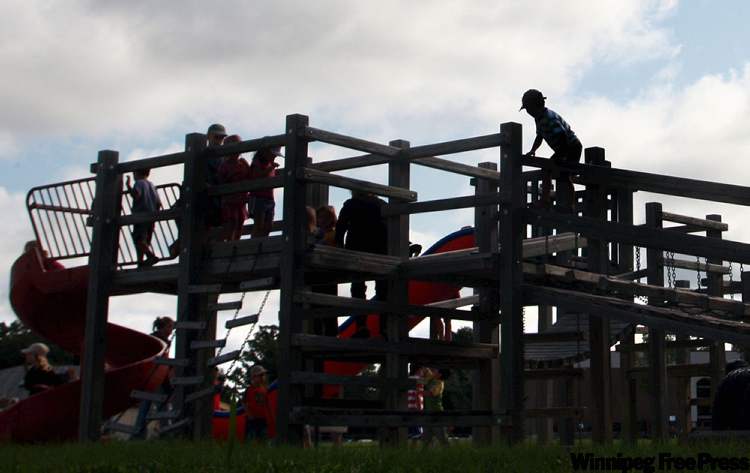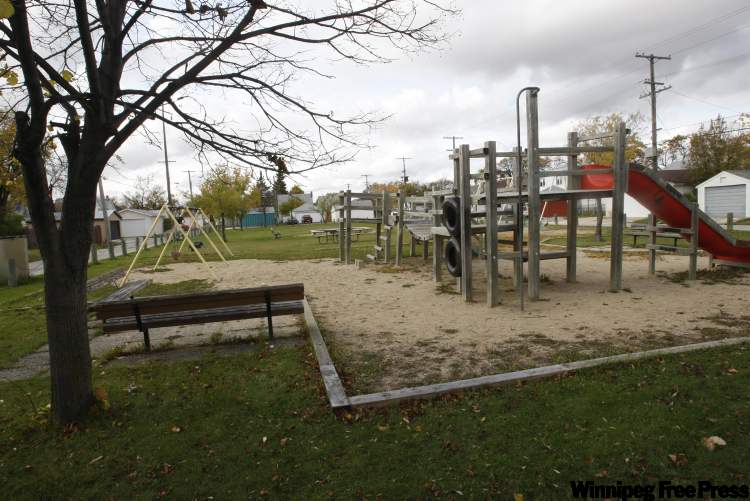Parks and wreck
Many of the city's 500 play structures are past their prime and potentially dangerous, but budget realities mean only 25 are replaced every year
Advertisement
Read this article for free:
or
Already have an account? Log in here »
To continue reading, please subscribe:
Monthly Digital Subscription
$0 for the first 4 weeks*
- Enjoy unlimited reading on winnipegfreepress.com
- Read the E-Edition, our digital replica newspaper
- Access News Break, our award-winning app
- Play interactive puzzles
*No charge for 4 weeks then price increases to the regular rate of $19.00 plus GST every four weeks. Offer available to new and qualified returning subscribers only. Cancel any time.
Monthly Digital Subscription
$4.75/week*
- Enjoy unlimited reading on winnipegfreepress.com
- Read the E-Edition, our digital replica newspaper
- Access News Break, our award-winning app
- Play interactive puzzles
*Billed as $19 plus GST every four weeks. Cancel any time.
To continue reading, please subscribe:
Add Free Press access to your Brandon Sun subscription for only an additional
$1 for the first 4 weeks*
*Your next subscription payment will increase by $1.00 and you will be charged $16.99 plus GST for four weeks. After four weeks, your payment will increase to $23.99 plus GST every four weeks.
Read unlimited articles for free today:
or
Already have an account? Log in here »
Hey there, time traveller!
This article was published 07/01/2012 (5105 days ago), so information in it may no longer be current.
Winnipeg has 500 play structures, four safety inspectors and more than 30,000 documents detailing inspections and injuries during a five-year period.
You can take a look at the paperwork, but it’ll cost you $26,000.
According to the city’s response to a freedom-of-information request, it will take more than 680 hours — at $15 per half hour — to gather hard-copy inspection reports, emails, electronic data and 311 call reports related to playground injuries.

The only information readily available, and at a fraction of the cost, is 20 reports on calls to 311 regarding play-structure injuries since the city information line opened three years ago.
Of those, 19 cases were resolved, in some cases by adding rubber grips to slippery patches, taping protruding wires or removing worn-out slides.
One caller said her daughter “smack(ed) her nose” on a slippery structure in January 2010. Thirty-six days later, a resolution was recorded.
“(The) park has a newer structure with conditions that may be slippery in our winter environment. The structure is sound with no repairs needed at this time,” wrote city staff.
Four months later, the same caller again reported that her child fell off the structure because it was too slippery. The case was closed a few days later without a descriptive resolution.
Only one structure received more than one complaint. It is in Rose Hill Park in Meadows West.
Three 311 complaints dating from September 2010 came in for Rose Hill — one about protruding objects in the surrounding sand that resulted in a child needing stitches and two from the same caller about a child’s fingers being caught in the chain of a swing.
While these issues were resolved, residents are still fighting for changes to the structure.
Jodie Dupas-Zemliduk’s two sons have been injured at the site. Her son, Easton, was running underneath the play structure’s bridge — which she says has metal bolts sticking out from it — and badly cut his head. Her other son, Fisher, once fell through the structure’s ladder.
“The bridge is the worst,” said Dupas-Zemliduk. “Other kids have cut their heads on it before. The whole structure is beyond repair.”
Dupas-Zemliduk drove Easton to the hospital, but didn’t call 311 to report the injury.
A study by IMPACT, the Winnipeg Regional Health Authority’s injury-prevention program, found more than 2,000 children visited the Children’s Hospital ER between 1998 and 2007 because of play-structure injuries. In one year alone, 2007, there were 243 such visits.
Point Douglas Coun. Mike Pagtakhan agrees Rose Hill needs an upgrade.
“It’s a tired old structure, about 17 to 18 years old,” said Pagtakhan, adding the useful life of a play structure is just over 17 years, but the city extends it to 20. “These are the living rooms of our communities, and you can’t build a community with a big old clunker.”
Because of budget restrictions, Rose Hill receives what Pagtakhan calls “Band-Aid solutions.” But he says he has no doubt the structure will be revamped with the 2012 budget, hopefully in July or August.
The city’s parks division has about $1.8 million to spend every year replacing amenities or entire play structures. Each year, one play structure from each ward is revamped. Dave Domke, the division’s manager, estimates the cost of a complete play structure overhaul at $100,000.

The city completes roughly 25 play-structure improvements a year with extra funding from the province.
daniella.ponticelli@gmail.com garrickkozier@gmail.com
OPEN SECRETS
With the help of Free Press staff, students in Red River College’s Creative Communications program learned how to mine freedom of information legislation for stories governments might not want told. At the start of the school year, students submitted access to information requests about everything from dangerous playgrounds to missing hospital drugs. In response, they got piles of documents and data, and one $26,000 bill. Over the next several weeks, the Free Press will publish some of the stories students uncovered. Visit www.winnipegfreepress.com to see them all.
ACCIDENT PREVENTION
Injuries on play structures are preventable — if you know what to look for.
“Ú Find out the suitable age range of a structure. There are two types, for ages five and under, or for children five to 12.
“Ú A child should be able to use all parts of a structure with ease. If you have to lift your child onto the structure to play, it’s not suitable. Little ones shouldn’t play higher than five feet — they are top-heavy and tend to receive more head and neck injuries.
“Ú Older children break their falls and are more likely to receive fractured forearms and elbows. Ensure the surface area surrounding the structure is made of soft materials such as sand either 15 centimetres deep for younger kids or 30 cm deep for older ones.
“Ú Be alert. If you see broken glass, sharp metal, needles or other maintenance and safety issues, call 311 and report it.
— Source: Dr. Lynne Warda, medical director of IMPACT

